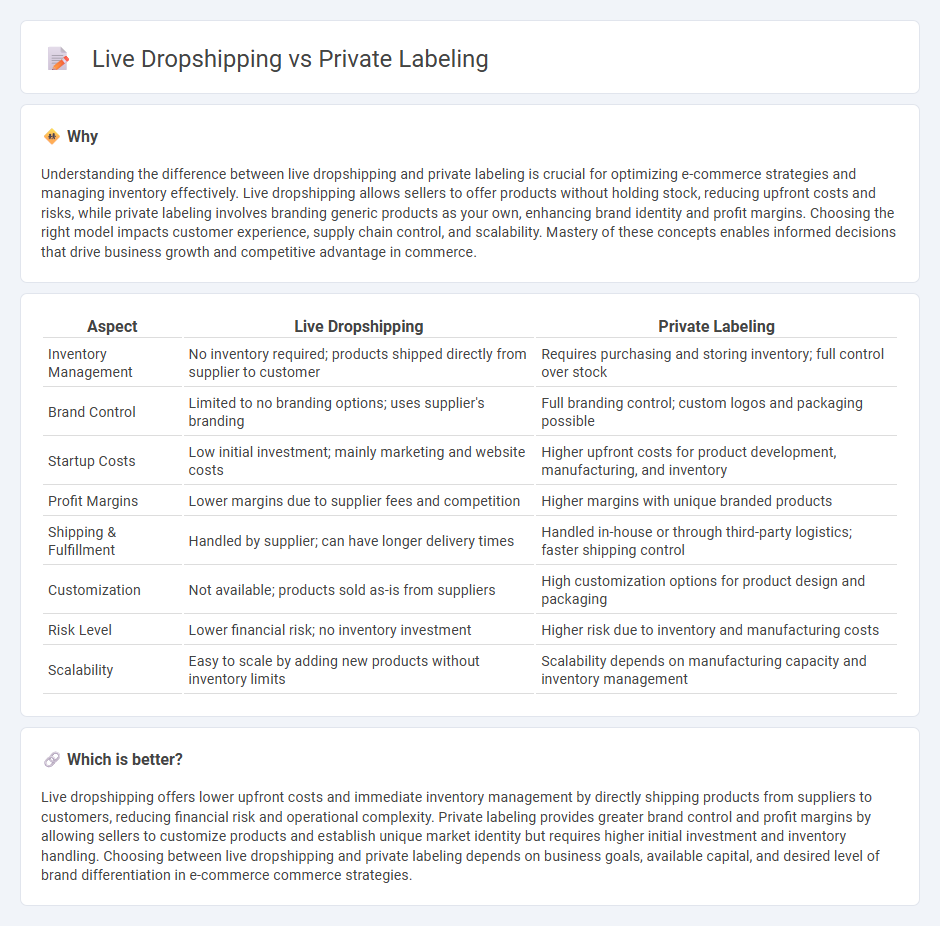
Live dropshipping enables entrepreneurs to sell products without holding inventory by directly shipping from suppliers to customers, reducing upfront costs and operational risks. Private labeling allows businesses to create a unique brand by sourcing generic products and customizing them with their own branding, offering higher profit margins and control over quality. Explore the advantages and challenges of live dropshipping and private labeling to determine the best strategy for your commerce goals.
Why it is important
Understanding the difference between live dropshipping and private labeling is crucial for optimizing e-commerce strategies and managing inventory effectively. Live dropshipping allows sellers to offer products without holding stock, reducing upfront costs and risks, while private labeling involves branding generic products as your own, enhancing brand identity and profit margins. Choosing the right model impacts customer experience, supply chain control, and scalability. Mastery of these concepts enables informed decisions that drive business growth and competitive advantage in commerce.
Comparison Table
| Aspect | Live Dropshipping | Private Labeling |
|---|---|---|
| Inventory Management | No inventory required; products shipped directly from supplier to customer | Requires purchasing and storing inventory; full control over stock |
| Brand Control | Limited to no branding options; uses supplier's branding | Full branding control; custom logos and packaging possible |
| Startup Costs | Low initial investment; mainly marketing and website costs | Higher upfront costs for product development, manufacturing, and inventory |
| Profit Margins | Lower margins due to supplier fees and competition | Higher margins with unique branded products |
| Shipping & Fulfillment | Handled by supplier; can have longer delivery times | Handled in-house or through third-party logistics; faster shipping control |
| Customization | Not available; products sold as-is from suppliers | High customization options for product design and packaging |
| Risk Level | Lower financial risk; no inventory investment | Higher risk due to inventory and manufacturing costs |
| Scalability | Easy to scale by adding new products without inventory limits | Scalability depends on manufacturing capacity and inventory management |
Which is better?
Live dropshipping offers lower upfront costs and immediate inventory management by directly shipping products from suppliers to customers, reducing financial risk and operational complexity. Private labeling provides greater brand control and profit margins by allowing sellers to customize products and establish unique market identity but requires higher initial investment and inventory handling. Choosing between live dropshipping and private labeling depends on business goals, available capital, and desired level of brand differentiation in e-commerce commerce strategies.
Connection
Live dropshipping and private labeling intersect through inventory management and brand identity control. Live dropshipping enables real-time product availability updates without holding stock, while private labeling focuses on customizing and branding products for exclusive market positioning. Together, they streamline supply chain efficiency and enhance consumer trust by merging seamless order fulfillment with personalized product offerings.
Key Terms
Branding
Private labeling allows businesses to create unique, branded products by partnering with manufacturers, enhancing brand identity and customer loyalty through exclusive offerings. Live dropshipping, while flexible and low-risk, relies on third-party suppliers, making consistent branding and product quality control more challenging. Discover the distinct advantages of each approach to strategic brand development.
Inventory Management
Private labeling requires upfront investment in inventory management, including warehousing, quality control, and stock forecasting to maintain brand consistency and meet customer demand. Live dropshipping eliminates inventory holding by directly shipping products from suppliers to customers, reducing overhead but relying heavily on supplier reliability and real-time inventory updates. Discover more about optimizing your inventory strategy to enhance operational efficiency and customer satisfaction.
Fulfillment
Private labeling offers greater control over product quality and branding, as manufacturers produce customized items exclusively for your business. Live dropshipping relies on third-party suppliers to fulfill orders directly to customers, resulting in faster setup but less control over packaging and inventory. Explore detailed strategies to optimize fulfillment in both models for improved customer satisfaction and business growth.
Source and External Links
What Is a Private Label? How Private Labels Work in 2025 - Private labeling is a business model where one company manufactures a product based on specifications, and another company brands, markets, and sells it exclusively under its own brand name, allowing retailers to offer unique products and control pricing.
Private Labeling vs. White Labeling: What's the Difference? - Private labeling involves exclusive products made for one retailer with customization options, giving brands competitive advantages such as higher profit margins and brand loyalty by controlling marketing and improvements.
Private label - A private label is a brand owned by a company that offers products made either by third-party manufacturers or its own facilities, usually exclusive to the retailer, differentiating it from white-label products which are more generic and sold to multiple brands.
 dowidth.com
dowidth.com